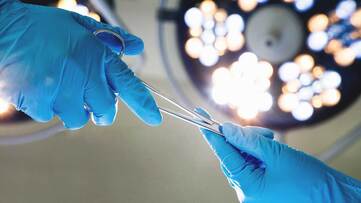 In this video Dr. Wilshire demonstrates how we excise (resect or completely remove) painful endometriosis lesions at the time of laparoscopy. Hello. This is Dr. Gil Wilshire at Missouri Fertility in Columbia, Missouri. Today, we are going to show you "endometriosis excision"; it is also called resection. Essentially, this is when we remove the endometriosis completely. If you will look on the screen now. This is a woman who had multiple previous surgeries but they did not excise all of her disease. You see this brown spot? This is endometriosis. This is brown, a little red, and it is also a little fibrous. There is a tiny little nodule here, and this needs to come out. Now, in this area there is the ureter, over here at the side, and the uterine arteries, so this is a somewhat tricky area to work. This is the general technique to do this. We will grab the lesion or the disease or the "boo-boo" or whatever you want to call it, and we pull it up—we pull it off to the side so we can see the nodule. You can see the nodule here—this is called tenting; we are tenting the lesion up. We are using electricity, but you can use ultrasound, you can use laser if you wish, but I prefer plain old electricity. You can see the cyst there as it popped. I like electricity as it is better at finding the blood vessels and stopping any bleeding from the blood vessels, whereas laser does not. So, we are tenting the lesion up here, cutting the membrane around it, which is called the perineum, and you can see the nodule coming out here. We are going to turn it so we can get a better approach here. We are tenting it up, and as we pull it away, it starts to separate from the underlying tissue. Here, we have a good angle on it, tenting it up, and it should be well away from the ureter and the uterine artery. And now, we should be able to get this lesion out in its entirety. We have the full nodule out, so we can cut it with these scissors…and there is the endometriosis. … Now, you can see, that is where it was. You can see the artery pulsing over here, and we have not hit it. This is no bleeding; this was completely bloodless and complete. This is an example of the excision of endometriosis. I hope that was interesting for you. This is Dr. Gil Wilshire at Missouri Fertility in Columbia, Missouri.
0 Comments
Your comment will be posted after it is approved.
Leave a Reply. |
�
Archives
March 2023
Categories
All
|
- About Us
-
Services
- Infertility >
- Fertility >
- Third Party Reproduction
- Reproductive Surgery
- Patient Resources >
-
Fertility Facts
>
- Age & Infertility
- Conception 101
- Endocrine Disorders
- Endometriosis
- Fallopian Tube Issues
- Female Infertility
- Infertility FAQs
- Infertility Myths
- Male Infertility
- PCOS
- Pelvic Pain
- Premature Ovarian Failure
- Recurrent Pregnancy Loss
- Secondary Infertility
- Sexually Transmitted Disease
- Unexplained Infertility
- Uterine Disorders
- IVF
- Blog
- Contact
- Patient Portal
|
|
Missouri Fertility
1506 E Broadway Suite 220 Columbia, MO 65201 [email protected] Phone: 573-443-4511 Fax: 573-443-7860 |
Patient Portal |

 RSS Feed
RSS Feed
